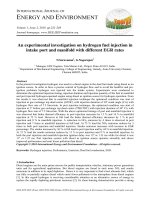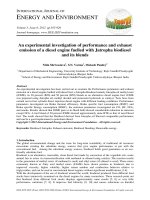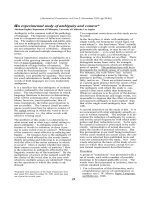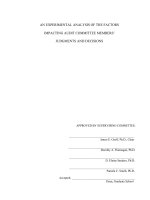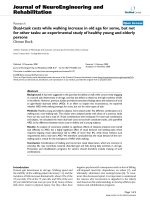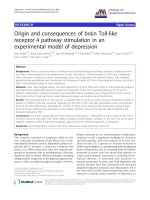An experimental investigation of single and multi tool micro EDM
Bạn đang xem bản rút gọn của tài liệu. Xem và tải ngay bản đầy đủ của tài liệu tại đây (20.07 MB, 185 trang )
AN EXPERIMENTAL INVESTIGATION OF SINGLE AND
MULTI-TOOL MICRO-EDM
MASHEED AHMAD
(B. Sc. in Mechanical Engineering, Bangladesh University of Engineering
and Technology)
A THESIS SUBMITTED
FOR THE DEGREE OF MASTER OF ENGINEERING
DEPARTMENT OF MECHANICAL ENGINEERING
NATIONAL UNIVERSITY OF SINGAPORE
2007
Acknowledgments
Acknowledgements
I would like to express my deepest and heartfelt gratitude and appreciation to my
Supervisor, Associate Professor A Senthil Kumar as well as my former Supervisor Dr.
Lim Han Seok, for their valuable guidance, continuous support and encouragement
throughout the entire research work. I would also like to convey my sincere gratitude to
Associate Professor Wong Yoke San for his valuable guidance and advice whenever it
was needed. Special thanks go to Professor Mustafizur Rahman for his kind
encouragement and support throughout the tenure.
I would like to take this opportunity to thank National University of Singapore (NUS) for
supporting my work by providing me with a research scholarship. I would also like to
thank Dr Son Seong Min for his valuable advice during my experiments.
I also would like to take this opportunity to thank the following staff for their help without
which this project would not be successfully completed: Mr Simon Tan Suan Beng, Mr
Tan Choon Huat, Mr Wong Chian Long from Advanced Manufacturing Lab (AML) and
Mr Lee Chiang Soon from Workshop 2 for their technical assistance throughout the
machining operations. Special thanks go to Mr Abu Bakar Md Ali Asad of NUS Spin-off
Company Mikrotools Pvt. Ltd. for his help with the machine set-up.
i
Acknowledgments
I would like to offer my appreciation for the support and encouragement during various
stages of this research work to the following labmates and friends: Wang Zhigang,
Mohammad Majharul Islam, Altabul Quddus Biddut, Sadiq Mohammad Alam,
Mohammad Sazedur Rahman, Indraneel Biswas, Sharon Gan, Woon Keng Soon,
Muhammad Pervej Jahan, Mohammed Muntakim Anwar, Angshuman Ghosh,
Muhammad Arifeen Wahed, Mohammad Iftekhar Hossain, Shaun Ho Pan Wei, Tina
Pujara and Toh Mei Ling. Special thanks to all of them for being my family for the past
two years.
Last but not the least, my heartfelt gratitude goes to my mother, Ms Naheed Ahmad, for
her loving encouragement and giving me hope throughout the whole period and my father,
Dr Gias uddin Ahmad, for telling me to remember that ‘research is like a sine wave – one
day you might be at the bottom but on the next, you’re on top of the world’. I would also
like to convey my sincere gratitude to my loving husband, Ahmed Arup Kamal for his
inspiration and my wonderful sisters, Farhana Ahmad and Lavina Ambreen Ahmed, for
always being there and supporting me. Special thanks go to my parents-in-law, Dr
Rowshon Kamal and Dr Ayesha Begum, for their encouragement.
ii
Table of Contents
Table of Contents
ACKNOWLEDGEMENTS
I
TABLE OF CONTENTS
III
SUMMARY
IX
LIST OF TABLES
XII
LIST OF FIGURES
XIII
CHAPTER 1
INTRODUCTION
1
1.1 Significance of Research
1
1.2 Objectives of Research
5
1.3 Thesis Organization
6
CHAPTER 2
LITERATURE REVIEW
8
iii
Table of Contents
2.1 Introduction
8
2.2 Historical Background of EDM
8
2.3 Overview of EDM Process
11
2.3.1 Principle of Operation
11
2.3.2 Types of Micro-EDM
13
2.3.3 Distinctive Features of Micro-EDM
14
2.3.4 EDM compared to other micromachining technologies
15
2.3.5 Key Systems Components
16
2.3.6 Types of Pulse Generators
16
2.4 Parameters of EDM Process
20
2.5 Machining Characteristics
25
2.5.1 Spark Gap
26
2.5.2 Material Removal Rate (MRR)
28
2.5.3 Surface Roughness
29
2.5.4 Tool wear ratio
31
2.6 Recent Developments, Applications and Challenges of Micro-EDM
33
2.7 Arrays of Micro-holes by EDM
37
CHAPTER 3
EXPERIMENTAL DETAILS
43
iv
Table of Contents
3.1 Introduction
43
3.2 Experimental Set-up
43
3.2.1 Multi-purpose Miniature Machine
3.3 Experiments with Single Electrode
43
45
3.3.1 Tool Material
45
3.3.2 Workpiece Material
46
3.3.3 Dielectric Fluid
48
3.3.4 Ceramic Guide Set-up
48
3.4 Experiments using Tools with Multiple Electrodes
50
3.4.1 Tool Fabrication
50
3.4.2 Tool Material
51
3.5 Measuring Equipments Used
3.5.1 Nomarski Optical Microscope
53
53
3.5.2 Scanning Electron Microscope (SEM) and Energy Dispersive X-ray (EDX)
Machine
54
3.5.3 Keyence VHX Digital Microscope
55
3.6 Machining Parameters
56
CHAPTER 4
RESULTS AND DISCUSSIONS: TOOLS WITH SINGLE ELECTRODE
58
4.1 Introduction
58
v
Table of Contents
4.2 Effect of Gap Voltage
59
4.2.1 Effect on Spark Gap
60
4.2.2 Effect on Machining Time
63
4.2.3 Effect on Tool Wear Ratio
66
4.3 Effect of Current
67
4.3.1 Effect on Spark Gap
68
4.3.2 Effect on Machining Time
71
4.3.3 Effect on Tool Wear
74
4.4 Effect of Pulse on Time
75
4.4.1 Effect on Spark Gap
75
4.4.2 Effect on Machining Time
78
4.4.3 Effect on Tool Wear
80
4.5 Effect of Pulse off Time
81
4.5.1 Effect on Spark Gap
82
4.5.2 Effect on Machining Time
83
4.5.2 Effect on Tool Wear
85
4.6. Combined Effect of Pulse on Time and Pulse off Time
86
4.7 Experiments using the RC type Pulse Generator Set-up
89
4.7.1 Effect of Capacitance
90
4.7.2 Effect of Voltage
93
vi
Table of Contents
4.8 Comparison of Surface Quality of Micro-holes Obtained by Transistor and RC type
Pulse Generators
97
4.9 EDX Analysis
100
CHAPTER 5
RESULTS AND DISCUSSIONS: TOOLS WITH MULTIPLE ELECTRODES 102
5.1 Introduction
102
5. 2 Machining Parameters
102
5. 3 Machining Performance
104
5.3.1 Surface Quality
104
5.3.2 Electrode Wear
109
5.3.3 Machining Time
112
5.3.4 Micro-hole Profiles and Dimensions
117
CHAPTER 6
CONCLUSIONS AND RECOMMENDATIONS FOR FUTURE WORK
120
6.1 Introduction
120
6.2 Conclusions
120
6.2.1 Tools with Single Electrode
120
6.2.2 Tools with Multiple Electrodes
123
vii
Table of Contents
6.3 Recommendations for Future Work
126
BIBLIOGRAPHY
129
LIST OF PUBLICATIONS
137
Appendix A
A-1
Appendix B
B-1
Appendix C
C-1
viii
Summary
Summary
Electro Discharge Machining (EDM) is potentially an important and cost effective nonconventional machining process for the fabrication of micro-tools, micro-components and
parts with micro-features. This process is capable of accurately machining parts with
complex shape, irrespective of the material hardness. In addition, it is a non-contact
process. Hence, EDM is gaining popularity essentially as micro-machining process.
However, a number of issues remain to be solved before micro-EDM can become a
reliable process with repeatable results and its full capabilities as a micro-manufacturing
technology can be realised.
Different machining parameters play important role in micro-EDM. But because of the
stochastic nature of the process, these parameters are yet to be well understood. Due to the
complicated discharge mechanisms, it is difficult to optimise the sparking process. The
optimisation of the process often involves relating the various process variables with the
performance measures maximising the material removal rate and surface quality, while
minimising the spark gap and tool wear rate. Therefore, it is necessary to know, in
advance, properties relating to these effects by means of experimental investigation by
taking into account machining characteristics such as spark gap, material removal rate,
surface quality and also tool wear.
ix
Summary
In view of this ongoing challenge to learn more about the nature of the micro-EDM
process, a series of rigorous experiments were conducted by using tungsten electrode of
300µm as a tool and Stainless Steel 304 Grade sheet with a thickness of 300µm as a
workpiece. The aim is to identify the optimum parameters and the machining trends of
die-sinking micro-EDM. The main parameters affecting the end results of the process
were identified and optimal parameter ranges for voltage, current (resistance), pulse on
time, pulse off time, short and open were found based on spark gap, machining time, tool
wear and surface quality. The effects of different types of pulse generators (transistor type
and RC type) were also investigated. A guiding attachment was also successfully modified
to reduce the wobbling of the tool electrodes.
The second part of this study is dedicated to drilling arrays of micro-holes by EDM. It is
known that holes of sub-micron diameter obtained by EDM are commonly found in
various daily life products such as, fuel injection nozzles, spinneret holes and biomedical
filters. Micro-EDM is also employed in making micro-mould and complex 3D structures,
in electronics, optical devices and in MEMS. In many of these applications arrays of holes
are required. To obtain a lot of individual structures by micro-EDM, each structure must
be machined sequentially by using a single electrode. However, the use of single tool
electrode has limits in throughput and precision because of positioning error and tool
wear. Replacement of worn electrode causes a decrease in productivity and shape
accuracy due to electrode positioning errors or variations in electrode dimension. This also
requires very long machining time. Tools with multiple electrodes can be an answer to
this. In this study, tools with an array of electrodes for micro-EDM were successfully
manufactured by micro-milling process using brass as the tool material. A series of
x
Summary
experiments were conduced using brass tools with different numbers of square multiple
electrodes and the surface quality of the micro-holes and the machining time along with
tool wear were investigated using transistor and RC type of pulse generators.
Therefore, this study is an attempt to shed some light into the micro-EDM process by
considering different process parameters using both single and multiple electrodes. A few
recommendations for taking the research further were also discussed at the end.
xi
List of Tables
List of Tables
Table 2.1 Compatibility of machining technologies with different materials
15
Table 3.1 Properties of Tungsten
46
Table 3.2 Composition of Stainless Steel
47
Table 3.3 Mechanical Properties of Stainless Steel 304 Grade
47
Table 3.4 Physical Properties of Stainless Steel 304 Grade
47
Table 3.5 Available Machining Parameters
57
Table 4.1 Fixed parameters for experiments to find the effect of voltage
59
Table 4.2 Fixed parameters for experiments to find the effect of current
68
Table 4.3 Fixed parameters for experiments to find the effect of pulse on time
75
Table 4.4 Fixed parameters for experiments to find the effect of pulse off time
82
Table 4.5 Parameters for experiments to find combined effect of Ton and Toff
86
Table 5.1 Machining Parameters for Experiments with Tools with Multiple Electrodes
103
Table 5.2 Average machining times for different number of electrodes in
transistor type set-up
113
Table 5.3 Machining times for different number of electrodes using RC set-up
115
Table 5.4 Average dimensions and average spark gaps for different conditions
118
Table 6.1 Optimal ranges of parameters for transistor type set-up
121
Table 6.2 Optimal ranges of parameters for RC type set-up
122
xii
List of Figures
List of Figures
Figure 2.1 Evolution of EDM research and world market through time
10
Figure 2.2 (a) RC type and (b) Transistor type pulse generators
17
Figure 2.3 Charge stored in both stray capacitance and condenser is discharged
19
Figure 2.4 Typical waveform of a voltage between the workpiece and
tool electrode during EDM. The pulse on time, Ton is the
duration when actual sparking occurs. Pulse off time, Toff
is when sparking is off, Total cycle, T consists of Ton and Toff.
22
Figure 2.5 Spark gap between workpiece and electrode
26
Figure 2.6 EDMed hole with taper
33
Figure 2.7 Problematic areas of micro-EDM
37
Figure 2.8 Concept of batch mode micro-EDM
38
Figure 2.9 (a) Tool with multiple electrodes made by LIGA and
(b) an array of holes obtained by using this tool
38
Figure 2.10 SEM view of array of cylindrical electrodes of diameter 100µm
39
Figure 2.11 Nozzle array produced in parallel by using electrode array
shown in Figure2.10
40
Figure 2.12 Micro-EDMn method
41
Figure 2.13 An array of square micro-holes
42
Figure 3.1 Structure of desk-top miniature machine tool used for the experiments
44
Figure 3.2 Multi-purpose Miniature Machine Tool with micro-EDM attachment
44
Figure 3.3 Detailed view of the set-up with micro-EDM attachment
45
Figure 3.4 Previous guide attachment with a V-groove and 3 wires
to guide the electrode
49
xiii
List of Figures
Figure 3.5 New guide attachment with the ceramic guide
49
Figure 3.6 New guide attachment with the ceramic guide on the machine set-up
50
Figure 3.7 Mori Seiki NV5000 high precision vertical machining center at AML
51
Figure 3.8 (a) Top view of the electrodes on the copper tool shows that the electrodes
are not uniform in dimension. (b) Top view of the electrodes on the
brass tool shows a more uniform dimensional accuracy.
52
Figure 3.9 (a) Electrodes on a copper tool show that the electrodes are not
straight in many places. (b) Electrodes on a brass tool show
that the electrodes are quite straight throughout the whole region.
52
Figure 3.10 Top view (a) and side view (b) of a single copper electrode shows
it has burrs on the surface and is not uniform.
53
Figure 3.11 Top view (a) and side view (b) of a single brass electrode shows
it does not have burrs and is more uniform.
53
Figure 3.12 Nomarski optical microscope (Olympus STM-6)
54
Figure 3.13 Scanning Electron Microscope (SEM) also with Energy
Dispersive X-ray (EDX) device
55
Figure 3.14 Keyence VHX Digital Microscope
56
Figure 4.1 Spark gap vs. voltage graph shows the spark gap increases
with increase in voltage
61
Figure 4.2 (a) Entrance diameter of 458µm with 125V, (b) Entrance diameter
of 450µm with 110V, (c) Entrance diameter of 441µm with
100V, (d) Entrance diameter of 420µm with 90V
61
Fig.4.3 Spark gap vs. voltage graph after using a ceramic guide shows
a lower range of spark gap
62
Figure 4.4 Entrance holes after using guide attachment by (a) 90V,
(b) 100V, (c) 110V, (d) 120V, (e) 130V, (f) 140V show
consistent dimensions with change in surface quality
63
Figure 4.5 Machining time vs. voltage graph shows the machining time
decreases with increase in voltage
64
xiv
List of Figures
Figure 4.6 Machining time vs. voltage graph after using the guide
attachment shows machining time decreases with
increase in voltage specifically, in the lower voltage range
65
Figure 4.7 Material removal rate against voltage graph shows the
material removal rate increases with increase in voltage
66
Figure 4.8 Tool Wear Ratio against voltage shows a linear increase in
tool wear with increase in voltage
67
Figure 4.9 Spark gap vs. current shows spark gap increases with increase in current
68
Figure 4.10 Entrance diameters of (a) 470µm with 20.6amps, (b) 460µm
with 9amps (c) 447µm with4.2amps, (d) Entrance diameter
of 428µm with 1.5amps
69
Figure 4.11 Spark gap vs. current after using the guide attachment
shows spark gap increases with increase in current
70
Figure 4.12 Entrance holes after using guide attachment by (a) 20.6amps,
(b) 9amps (c) 4.2amps, (d) 1.5amps show more consistent in
dimension with change in surface quality
71
Figure 4.13 Machining time vs. current shows time reduces with increase in current
72
Figure 4.14 Machining time vs. current graph after using the guide
attachment shows machining time decreases with increase
in current with a reduction to the whole range
73
Figure 4.15 Material removal rate against current graph shows the material
removal rate increases with increase in voltage
73
Figure 4.16 Tool Wear Ratio against current shows a linear increase
in tool wear with increase in current
74
Figure 4.17 Spark gap vs. pulse on time graph shows spark gap
does not change significantly
76
Figure 4.18 Entrance holes with Ton values of (a) 3µsec, (b) 6µsec,
(c) 12µsec, (d) 18µsec, (e) 24µsec, (f) 30µsec show
similar dimensions and surface profiles
77
Figure 4.19 Spark gap vs. pulse on time graph at a higher Ton range
shows a larger range
78
Figure 4.20 Machining time vs. pulse on time graph shows it takes
less time with higher values of Ton
79
xv
List of Figures
Figure 4.21 Machining time vs. pulse on time graph at a higher Ton
range shows a larger range
79
Figure 4.22 Taper against pulse on time for a range of lower pulse on time
80
Figure 4.23 Taper against pulse on time for a higher range of pulse on time
81
Figure 4.24 Spark gap vs. pulse off time graph shows spark gap
does not vary significantly with Toff
82
Figure 4.25 Spark gap vs. pulse off time graph at a higher Toff range
shows a similar range
83
Figure 4.26 Machining time vs. pulse off time graph shows machining
time does not change very significantly with Toff
84
Figure 4.27 Machining time vs. pulse off time graph shows a similar range
84
Figure 4.28 Taper against pulse off time for a range of lower pulse off time
85
Figure 4.29 Taper against pulse off time for a range of higher pulse off time
86
Figure 4.30 Spark gap against pulse off time for different values of pulse on time
87
Figure 4.31 Machining time against pulse off time for different values of pulse on time 88
Figure 4.32 Taper against pulse off time for different values of pulse on time
89
Figure 4.33 Spark gap against capacitance graph shows consistent results
90
Figure 4.34 Entrance holes by capacitance values of (a) 4700pF, (b) 2200pF,
(c) 470pF, (d) 220pF and (e) 100pF show almost identical
dimensions and surface profiles
91
Figure 4.35 Machining time against capacitance graph shows a decreasing
trend with the increase in capacitance
92
Figure 4.36 Tool wear ratio against capacitance graph shows an increase
in tool wear with capacitance
93
Figure 4.37 Spark gap against voltage graph shows consistent results
94
Figure 4.38 Entrance holes by voltage values of (a) 70V, (b) 80V, (c) 90V,
(d) 100V show almost identical dimensions and surface profiles
94
Figure 4.39 Machining time against voltage graph shows an almost linear
xvi
List of Figures
decreasing trend with the increase in voltage
95
Figure 4.40 Tool wear ratio against voltage graph shows an increase in
tool wear with voltage
96
Figure 4.41 Entrance holes after using (a) Transistor type pulse generator and
(b) RC type pulse generator
97
Figure 4.42 SEM images of the exit side of a typical hole obtained by using
(a) transistor type pulse generator and (b) RC type pulse generator
99
Figure 4.43 SEM images of the entrance side of a typical hole obtained by using
(a) transistor type pulse generator and (b) RC type pulse generator
99
Figure 4.44 EDX analysis of a hole machined by using transistor type
pulse generator
100
Figure 4.45 EDX analysis of a hole machined by using RC type pulse generator
101
Figure 5.1 SEM picture of a square hole obtained by using transistor type pulse
generator set-up using a higher energy level (with 15Ω)
106
Figure 5.2 SEM picture of a square hole obtained by using transistor type pulse
generator set-up using a lower energy level (with 33Ω)
106
Figure 5.3 SEM picture of a square hole obtained by RC type pulse generator set-up 106
Figure 5.4 SEM pictures of square holes obtained by using pulse generator
set-up (15Ω and 33Ω) and RC set-up by using brass tools
with (a) 37 electrodes, (b) 61 electrodes and (c) 121 electrodes
on 50µm thick stainless steel workpieces.
108
Figure 5.5 A brass tool with 37 uniform micro-electrodes shows each
electrode to have sharper edges and straight surfaces before machining
109
Figure 5.6 A brass tool with 37 micro-electrode shows each electrode to
have worn off and blunt edges after machining
110
Figure 5.7 (a) A single electrode from a tool with 37 electrodes before machining
showing straight profile. (b) A single electrode from a tool with 37
electrodes after machining with transistor type pulse generator
set-up showing worn off and elliptical profile (c) A single electrode
from a tool with 37 electrodes after machining with RC type pulse
generator set-up showing worn off and rounded profile
111
Figure 5.8 Graph of machining times for different number of electrodes using
two different levels of energy in the transistor type set-up
112
xvii
List of Figures
Figure 5.9 Graph of machining times for different number of electrodes using
RC type pulse generator
115
Figure 5.10 Graph of magnitude of reduction in machining time for different number
of electrodes using two different settings (15Ω and 33Ω) of the transistor
type pulse generator set-up and RC type pulse generator set-up
116
Figure 5.11 Graph of spark gap along no of electrodes obtained by using transistor
type and RC type pulse generators shows RC type set-up gives holes
closer to the tool dimension
118
Figure 5.12 (a) Top surface of single electrode tool before machining shows the edges
are slightly rounded. (b) A square hole after machining using transistor
type set-up has irregular edge
119
Figure 5.13 (a) Top surface of single electrode tool before machining shows the edges
are slightly rounded. (b) A square hole after machining using RC
set-up has rounded edges
119
Figure 5.14 (a) Top surface of a electrode from the tool with 37 electrodes before
machining shows the edges are slightly rounded. (b) A square
hole after machining using RC set-up has rounded edge
119
xviii
Introduction
Chapter 1
Introduction
1.1 Significance of Research
Electro Discharge Machining (EDM) is a non-traditional machining technology that has
been found to be one of the most efficient technologies for fabricating micro-components.
The non-contact process requires no force between the electrode and work-piece and is
capable of machining all sorts of electrically conductive materials – be it ductile, brittle or
super hardened material. The micro-EDM process is based on the thermoelectric energy
created between a workpiece and an electrode submerged in a dielectric fluid. In this
process, two electrodes (one is the tool electrode and the other is the workpiece) are
positioned together and subjected to a voltage. When sparks are generated the electrode
materials will erode and in this way material removal is realized [Alting et. al., 2003].
Basically, there are two different types of EDM: die-sinking and wire-cut. Die-sinking
EDM reproduces the shape of the tool used (electrode) in the part whereas in wire-cut
EDM or wire-EDM, a metal wire (electrode) is used to cut a programmed outline into the
piece. As mentioned before, in recent years, numerous developments in EDM have
focused on the production of micro-features. Micro-EDM is being considered as one of
the most promising methods in terms of size and precision. It has advantage over other
fabrication processes, such as LIGA (a photo- lithography method), laser, ultrasonic, ion
1
Introduction
beam etc, because of its lower cost. Also the majority of such non-conventional processes
are slow and limited in planar geometries. Very small process forces and good
repeatability of the process results have also made micro-EDM the best means for
achieving high-aspect-ratio micro-features [Pham et. al., 2004].
In EDM, the machining characteristics are mostly influenced by the values of various
parameters chosen. But because of its stochastic nature, process parameters are still at
development stage and their effects on performance measures have yet to be clarified
[Pham et. al., 2004]. Due to the complicated discharge mechanisms, it is difficult to
optimise the sparking process. The optimisation of the process often involves relating the
various process variables with the performance measures maximising the material removal
rate, while minimising the tool wear rate and yielding the desired surface profile
[Masuzawa, 2000]. Another important performance measure is the spark gap. For EDM,
there must always be a small space, known as the spark gap, between the electrode and the
work piece. This spark gap affects the ability to achieve good dimensional accuracy and
good finishes. The lower and consistent in size of the gap, the more predictable will be the
resulting dimension. Different process parameters play important role on spark gap,
material removal rate, tool wear and surface quality. With appropriate parameters, it is
possible for micro-EDM to achieve high precision machining [Lim, H. S., et al., 2003].
That is why it is very important to measure the amount of deviation from the desired
performance measures and identify the crucial process variables affecting the process
responses. Since the selection of proper cutting parameters is required to obtain the higher
cutting efficiency or accuracy in micro-EDM, the need for the knowledge of precise
values for optimum parameter is a must. Different types of pulse generators also affect the
2
Introduction
end result in micro-EDM. Therefore, it is also important to investigate the effect of using
different pulse generators.
For the die-sinking type EDM, micro-holes are the most basic products of
micromachining. Holes of sub-micron diameter obtained by EDM are commonly found in
various daily life products such as, fuel injection nozzles, spinneret holes and biomedical
filters. Micro-EDM is also employed in making micro-mould and complex 3D structures,
in electronics, in pharmaceutical industry and optical devices and in MEMS [Masuzawa,
2000; Alting et al., 2003]. In many applications, specially in bioengineering applications,
arrays of holes are required and the need for them is increasing day by day [Liu et. al.,
2005]. To obtain an array of holes by micro-EDM, each hole must be machined
sequentially by using a single electrode. However, the use of single tool electrode has
limits in throughput and precision because of positioning error and tool wear.
Replacement of worn electrode causes a decrease in productivity and shape accuracy due
to electrode positioning errors or variations in electrode dimension. This also requires very
long machining time. Tools with multiple electrodes can be an answer to this.
The most common method used to obtain tools with multiple electrodes of high precision
is the LIGA process [Takahata et. al., 1999; Kunieda et. al., 2005]. However, this is an
expensive process. Other problems like void formation and adhesion problems may also
occur in fabricating high aspect ratio electrodes by LIGA process. Another successful way
to get an array of electrodes is by following a number of steps of micro-EDM processes
[Masaki et. al., 2002]. These processes start off by making a single electrode with Wire
Electro Discharge Grinding (WEDG) and then going on to make a pattern of holes using
3
Introduction
this electrode. This pattern is then used to make an array of electrodes on a block by
reversing polarity which is later on used as the tool for EDM. However, this is a very time
consuming method. To overcome the problems of high expense and high machining time,
an alternative way is needed to be ventured.
Although aforementioned non-conventional machining processes have been successfully
applied in many areas, the gap between conventional and non-conventional machining
processes are getting narrower. As the non-conventional machining processes are
becoming more and more commonplace, they are no longer isolated from already
recognized prevalent processes such as turning, milling and drilling. The incorporation of
both conventional and non-conventional machining processes to achieve a single goal will
open up better potential. Multi-process micro machining is becoming the trend of future
fabrication technology. In this light, a conventional machining process, such as milling,
can be an answer to obtain a tool with multiple electrodes. This process might be faster,
more economical and provide good repeatability.
Thus, to make a comprehensive study on micro-EDM, identifying the major parameters in
the first place and then understanding the behavior of individual parameters and also their
interacting effect on the machining characteristics is very important. After understanding
the nature of micro-EDM, it is equally important to investigate the possibilities of more
practical applications of the process, such as getting an array of micro-holes in one shot by
using EDM. And to achieve this goal, it is also imperative to go beyond non-conventional
processes and venture more common conventional processes and try to find the feasibility
4
Introduction
of combining conventional and non-conventional methods to obtain the right tool for
micro-EDM to reach the goal.
1.2 Objectives of Research
The aim of this project is to make a comprehensive study and investigation to find the
optimum parameters of die-sinking micro-EDM. Another purpose of the project is to find
the feasibility of venturing a conventional process to obtain a tool with multiple electrodes
for micro-EDM of an array of holes. While pursuing this, other possibilities, such as the
effect of using different pulse generator set-ups and using a guiding attachment to reduce
the wobbling of electrodes, are also to be investigated. The following objectives are to be
achieved in this study:
To investigate the effect of different process parameters of micro-EDM using the
transistor type pulse generator set-up.
To investigate the effect of different process parameters of micro-EDM using a
guiding attachment.
To investigate the effect of different process parameters of micro-EDM using the RC
type set-up and make a comparison.
To make tools with multiple square electrodes of different materials for micro-EDM
by using micro-milling process and to study which one possesses better dimensional
accuracy.
To investigate the surface quality, machining time and electrode wear using tools with
different numbers of electrodes by using both transistor type pulse generator set-up
and RC type set-up.
5
Introduction
1.3 Thesis Organization
There are six chapters in this dissertation. In Chapter 2, a comprehensive review is given,
which includes the historical background of EDM, an overview of the EDM process,
different parameters and controllers found in EDM, recent developments in micro-EDM
with respect to tools with both single and multiple electrodes.
Chapter 3 describes the experimental details. This is done in five parts. In the first part,
details of the experimental set-up are first given. The second part illustrates the
experimental details for the experiments done with single electrode, i.e., selection of tool
and workpiece materials and a brief description of the guide attachment. The third part
highlights the details for experiments done with tools with multiple electrodes such as tool
material and tool fabrication. The fourth part gives brief descriptions of the different
measuring equipments used while the fifth part illustrates the experimental method
followed throughout the course of study. The fifth part illustrates a summary of the
different machining parameter settings used throughout the experiments.
Chapter 4 describes the results and discussions obtained from the experiments done by
using single electrodes. This gives a detailed analysis of the effects of different parameters
of the micro-EDM process, by using both the transistor and RC type pulse generators,
with respect to spark gap, machining time, tool wear and surface quality.
Chapter 5 describes the results and discussions obtained from the experiments done by
using tools with multiple electrodes. This gives a detailed analysis of the results showing
6
